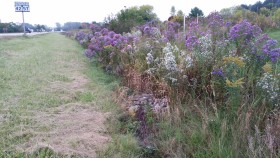TRAIL CONDITIONS: All trails are open for hiking. We will not groom unless we receive significant snow. Icy patches. The plaque on the Collins Learning Center reads “Dedicated to the Advancement of Scientific, Cultural and Historical education for the people of Door County. And the people of Door County is all of us—the natives, the transplants, summer people, tourists, the transient workforce. All of us.
The plaque on the Collins Learning Center reads “Dedicated to the Advancement of Scientific, Cultural and Historical education for the people of Door County. And the people of Door County is all of us—the natives, the transplants, summer people, tourists, the transient workforce. All of us.
We can live and work and visit here because the county can accommodate everybody. There are places to stay and food to eat. But imagine, if you would, what would happen during, say, August, September, and October if all of the restaurants, grocery stores and hotels were closed. Where would people eat? Or stay? What would people eat? Would people come here to visit? Would there be work for the work force? Could parents feed their children? This would be a disaster.
Now think of the pollinators of Door County. Most of our pollinators are bees–domestic honeybees and wild native bees. But there are butterflies and hummingbirds also. These pollinators are the natural workforce. They are the workers that pollinate the cherries and apples for which Door County in known. And our pollinators are essential for some agricultural crops and also many of the garden vegetables on which we humans depend.
Understand that for insects, this is not an intentional good deed. They do not intend to carry pollen from one flower to another. But they do gather nectar and pollen and in the process, they fertilize many of the plant species which we find desirable. Pollinators collect nectar and pollen from flowers to feed themselves and to feed their babies.
Pollinators do pretty well in Door County during spring and summer. There are woodland wildflower and orchards and the field flowers….more than enough for the insects and their offspring and so their populations grow. More insects need more flowers. But in late summer, just when the need is greatest, the woodlands are dark, the orchards are long past blooming, and the fields and roadsides are mowed. Fields are mowed for hay. Understandable.
Roadsides are mowed because….because…I really don’t know. Maybe it’s because we’ve always mowed roadsides. And we have a lot of money invested in mowing equipment.
Yet mowing is the equivalent of closing all of the restaurants and all of the grocery stores in the county. When we mow down our flowers, we are starving the insect workforce and their offspring… just when honeybees need to make the honey they require to survive the winter, just when the wild bees need to the most pollen, just when migrating butterflies such as monarchs are passing through the peninsula, we mow. We remove the flowers that are essential for food and the habitat necessary for nesting.
Plus roadside flowers are gorgeous. Tourist love them. Locals love them. They are just as colorful as autumn leaves…they’re just closer to the ground. If you don’t believe it, join the Wild Ones of Door County at their February meeting at 4:00 on Sunday, February 28 at the Collins Learning Center.
Wild Ones President Dr. Peter Signmann will present “Roadside Wildflowers”. He photographed wildflowers of all types while bicycling the county and tow roads of the peninsula for one year. The resulting slide show demonstrates the visual attractiveness of the roadsides. Roadsides are corridors of insects, birds and mammals that have to travel in search of food, mates or suitable climate. The presentation will be followed by a discussion concerning ways to properly care for the roadside vegetation.
Crossroads at Big Creek is a donor supported preserve welcoming learners of all ages to programs in science history and the environment. The Collins Learing Center, located at 2041 Michigan, is open 2:00-4:30 daily and during scheduled events.
4:00 Wild Ones Lecture: Preview of Spring and Summer: Roadside Wildflowers.
Wild Ones President Dr. Peter Signmann will present “Roadside Wildflowers”. He photographed wildflowers of all types while bicycling the county and tow roads of the peninsula for one year. The resulting slide show demonstrates the visual attractiveness of the roadsides. Roadsides are corridors of insects, birds and mammals that have to travel in search of food, mates or suitable climate. The presentation will be followed by a discussion concerning ways to properly care for the roadside vegetation.

